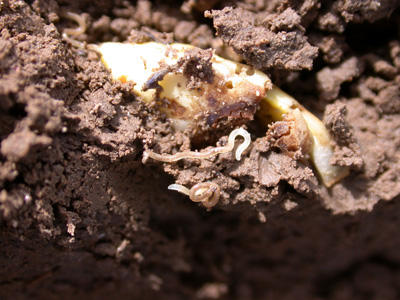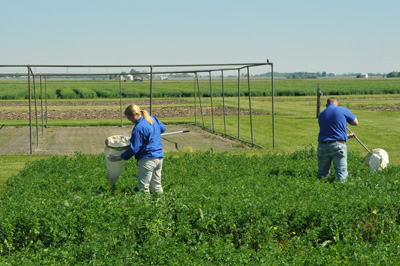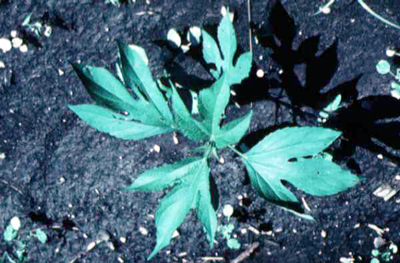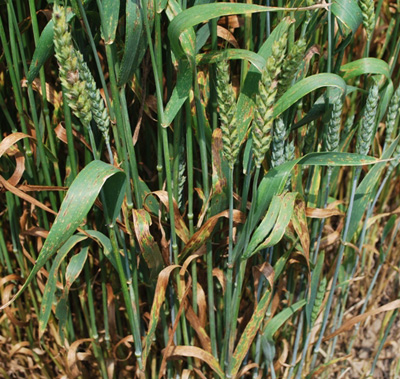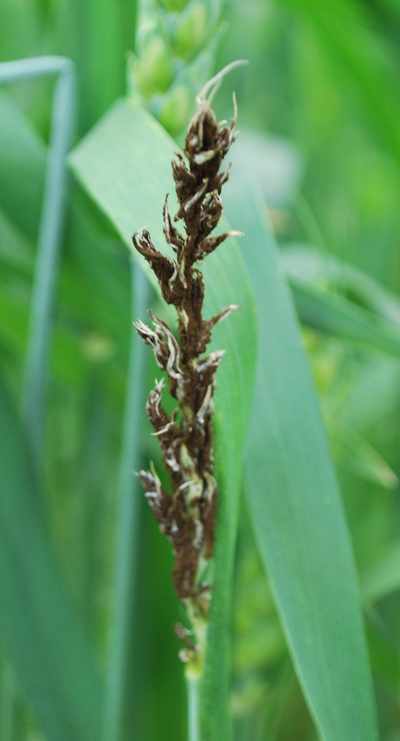Pest & Crop Newsletter, Entomology Extension, Purdue University
- Dead/Dying Seedlings, Critters Aplenty
- It's Potato Leafhopper in Alfalfa Time
- Black Light Trap Catch Report
Dead/Dying Seedlings, Critters Aplenty – (Christian Krupke, John Obermeyer and Larry Bledsoe)
- Numerous pests and non-pests are being found in poor emerging/growing fields.
- Some animals are feeding on dead/decaying plant
material. - A plethora of pests are being reported, even where seed-insecticides have been used.
Finally the sun is out, fields are drying, and temperatures are increasing. As pest managers inspect crops that have been subjected to an extended period of poor growing conditions, a multitude of critters are being found in the soil. Some are known pests and several are being falsely accused of causing stand reductions.
It’s not a wireworm: Millipedes are wireworm-like arthropods (like insects, they belong to the Phylum Arthropoda-means “jointed foot”), having two pair of legs per body segment that move quickly above and below the ground. They have become more prevalent since the advent of no-till. When found, their numbers are often high. Millipedes typically feed as scavengers, feeding on dead or decaying materials often associated with seedling blights. They have rarely been documented as pests of corn. Several pest managers have reported numerous millipedes in and around corn kernels/sprouts that have been in the ground for two or more weeks. The opportunistic millipedes were hollowing out these “blank” kernels that were in early stages of decay.
Millipedes damaged this seedling growing in an open seed slot...planted too wet
It’s not a nematode: Juvenile (“baby”) earthworms and potworms are closely related and common animals found in soils. They are small, colorless, and often less than 1/4 inch long. As you would expect, these worms feed on damaged and decaying plant remains, not live tissue. Therefore they are closely associated with the decaying plant parts and surrounding soil and often wrongly accused of damaging seedlings – in fact, they usually arrive after the seed is dead and are incapable of causing damage to live tissue. Pest managers should keep an open mind when diagnosing field problems. As one submitter confessed, he was so convinced that it was an insect problem and therefore looked for anything moving when he couldn’t find grubs or wireworms.
Potworms next to rotting soybean seed
Many other critters, e.g., mites, symphylans, and springtails, have been observed on or around rotting seeds/seedlings. They are small, some fast moving, and certainly unfamiliar to most. They are not causing the poor emergence/growth, but taking advantage of weak and dying plants in various stages of decay.
Grubs, wireworms, seedcorn maggots, and cutworms are all notorious for seeding damage and reduced plant stands especially under poor growing conditions. It has been learned after years of use, that low rates of seed-applied insecticides (i.e., Cruiser and Poncho) are not preventing economic stand losses from grubs, wireworms and cutworms where populations are high. The product label specifies “protection,” from these early season pests. The problem is that these systemic insecticides require a vigorously growing plant for uptake, yet they are most needed when the environment is not conducive to growth.
![]()
It’s Potato Leafhopper in Alfalfa Time - (Christian Krupke, John Obermeyer, and Larry Bledsoe)
- Sample newly cut alfalfa fields for leafhoppers.
- If yellowing has already occurred, it is too late to
prevent damage to this cutting. - Management guidelines are given.
Sweeps in forage fields have shown that potato leafhoppers have arrived to Indiana in large numbers and populations will only be increasing with the warmer temperatures – these are insects that thrive in the heat. Alfalfa pest managers should begin sampling their alfalfa shortly after cutting.
Potato leafhoppers are small, wedge-shaped, yellowish-green insects that remove plant sap with their piercing-sucking mouthparts. Leafhopper feeding will often cause the characteristic wedge-shaped yellow area at the leaf tip, which is referred to as “hopper burn.” Widespread feeding damage can cause a field to appear yellow throughout – if you see this visual evidence, the damage is already done and treatment will not help this cutting. Leafhopper damage reduces yield and forage quality through a loss of protein. If left uncontrolled for several cuttings, potato leafhoppers can also significantly reduce stands.
Sweep net practice at the DTC
The need to treat for leafhoppers can be determined prior to the appearance of damage if fields are surveyed on a regular basis. To assess leafhopper populations and the potential for damage, take at least 5 sets of 20 sweeps with a 15” diameter sweep net in representative areas of a field. Carefully examine the contents of the sweep net, count the number of adults and nymphs, and calculate the number of leafhoppers per sweep. Use the guidelines given below to determine the need for treatment. Usually the best results are obtained when treating small alfalfa, so be sure to scout the alfalfa regrowth for leafhoppers after cutting. For recommended insecticides see Extension Publication E-220, Alfalfa Insect Control Recommendations - 2009 which can be viewed at <http://extension.entm.purdue.edu/publications/E-220.pdf>.
| Management Thresholds for Potato Leafhoppers | |
| Stem Height in Inches | Leafhoppers (Adults/Average Number Nymphs) Per Sweep |
| under 3 | 0.2 |
| 4 - 6 | 0.5 |
| 7 - 12 | 1.0 |
| greater than 12 | 1.5 |
![]()
Click here to view the Black Light Trap Catch Report
![]()
When Should Weeds be Treated with Postemergence Herbicides? – (Tom Jordan, Bill Johnson, Glenn Nice, and Tom Bauman)
Timing of postemergence herbicides for maximum efficacy is critical. While all fields cannot be sprayed at the ideal weed height according to the label due to rain, high winds, or not being able to get to a field on a timely basis, it is still critical to treat weeds as close to ideal times as possible. When the critical time period is missed, knowing how weeds respond to herbicides will allow you to predict the performance of that application. This can help in determining what additional management practices may be needed to achieve acceptable weed control.
Starting with a weed-free field at planting time; from a good burndown, early preplant herbicide, or tillage; provides the best chance of giving the crop a head start on weeds. When weeds emerge before or at the same time as the crop, maximum competition between the weeds and the crop comes in the second to forth week after crop emergence. This time span will depend on the soil moisture and temperature available to the plants. Weed Scientists use a phrase “Critical Period for Weed Control” to describe the time when weeds should be controlled to keep them from competing with crops. When a preplant or preemergence herbicide provides weed control at planting, the critical period is the time needed for the herbicides to provide control while the crops gets established, so that later emerging weeds will have minimum effects on crop yield. This period of control is usually the first four to six weeks in the life of the crop. Annual weeds that emerge after the critical period for weed control will not only have a minimum yield impact, but will also produce fewer seeds to replenish the soil seed bank. They can however, interfere with harvest efficacy, which may contribute to some yield loss or reduced grain quality.
The longer the herbicide application is delayed beyond the critical period for weed control, not only does competition increase, but also weeds are taller and more mature, making them harder to control. With delayed applications, environmental conditions become less favorable for herbicides to be absorbed and move to sites of action in the weeds to completely kill them. Older, taller weeds get less herbicide coverage and thicker leaf cuticles with dust on them decrease the absorption of herbicide solutions.
For annual weeds, best results are seen when the applications are made to small plants growing under good environmental conditions and receiving complete spray coverage. Think of the control obtained when spraying a two to six inch tall giant ragweed compared to a two to three foot tall giant ragweed. For perennial weeds, which are usually found in a field at lower populations in patches, the best results occur with translocated herbicides when the plants are taller and transitioning from the vegetative stage to the reproductive growth stage. This is usually just prior to or during bloom stage of the plant. Treating small rapidly growing perennial plants usually only provides temporary top kill and regrowth occurs. Taller more mature plants provide a greater opportunity for the herbicide to translocate throughout the plant, increasing the chances of obtaining complete control.
Most postemergence herbicide applications are timed for annual grasses and broadleaf weeds that comprise the majority of the weed population in a field. Additional applications are needed for the perennial weeds that are present. The following figures show the response of annual and perennial weeds to herbicides over the course of their lifecycle. These figures show how annual weeds are best controlled early in their lifecycle when they are small, while perennial weeds are more susceptible to translocated herbicides later in their lifecycle. The success of a translocated herbicide to control perennial weeds is dependent on timing the application to coincide the plant translocating food sources (sugars) to reproductive areas within the plant. The success of any herbicide to control annual weeds is timing the application to provide good coverage to the plants when they are small, prior to the time they begin to compete with the crop. In most cases, one application will be made to control both annual and perennial weeds present in that field with the timing of the application made for the annual weeds. This does not mean that perennial weeds will not be controlled; it only means that if the growth stage of the perennial weed is small, then the chances of regrowth is greater than if it were closer to the bloom stage.
Lambsquarter
Giant ragweed
![]()
Wheat Disease Update – (Kiersten Wise)
Fusarium head blight (scab) is present in research plots and commercial fields in southern Indiana. Research plots in Posey County had between 5 and 30% incidence of Fusarium head blight as of this week. Even commercial fields that received a fungicide application at flowering had low levels of Fusarium head blight infection. We will continue to see symptom expression of Fusarium head blight (Figure 1) over the coming weeks. At this point, there are no “rescue” treatments to control Fusarium head blight, and DON-contaminated grain may be a concern for producers in southern Indiana this year. When harvesting fields with Fusarium head blight infection, producers should blow scabby kernels out the back of the combine at harvest.
Figure 1. Fusarium head blight infection in Posey County.
Heads of wheat in southern Indiana are not only infected with Fusarium head blight, but also glume blotch, caused by the fungus Stagonospora nodorum. This fungus also causes a leaf blotch that is prevalent in southern Indiana this year, and in some plots lesions were present on the flag leaf, and lower leaves were severely diseased (Figure 2). Glume blotch symptoms appear after flowering and dark brown glumes with dark pycnidia in the center of the lesions are characteristic of the disease.
Figure 2. Stagonospora leaf blotch and glume blotch on plants near Evansville, IN.
Loose smut was observed in Posey County, as well as in Tippecanoe County in northern Indiana. This fungal disease, caused by Ustilago tritici, infects seeds and produces wheat heads with glumes composed of masses of black spores called teliospores (Figure 3). These spores move from infected heads to healthy heads during flowering, resulting in seed infection.
Figure 3. Loose smut on wheat in Tippecanoe County
Planting clean, disease-free seed is essential for managing loose smut and glume blotch. Seed treatments are also available and should be considered if loose smut is observed in a field.
Weather information is unavailable this week


